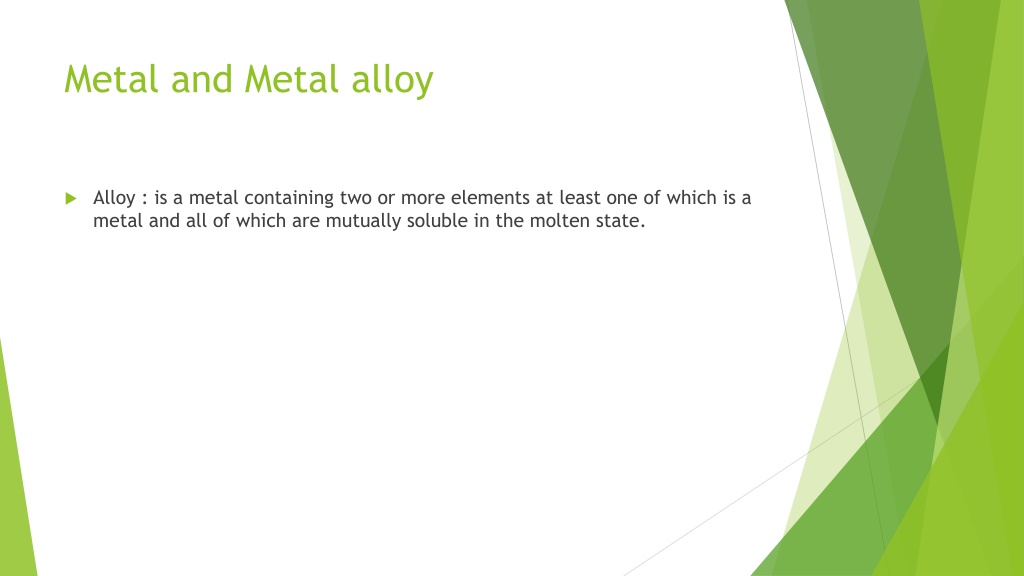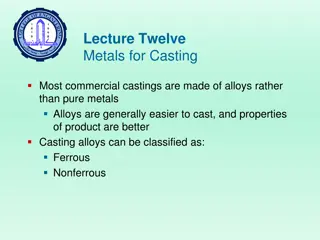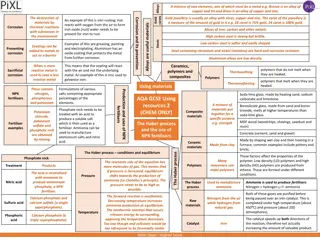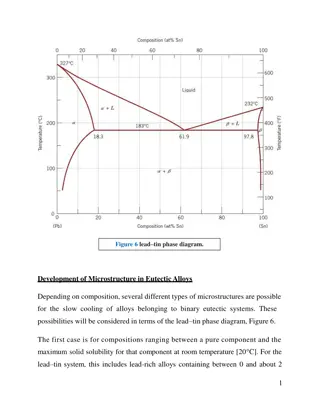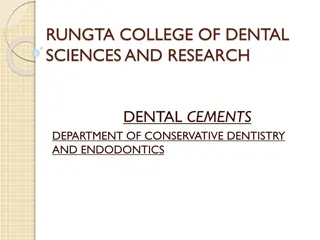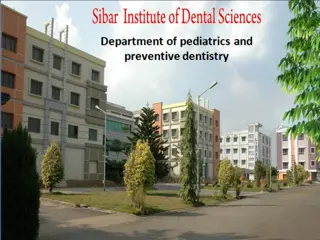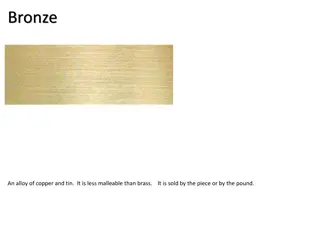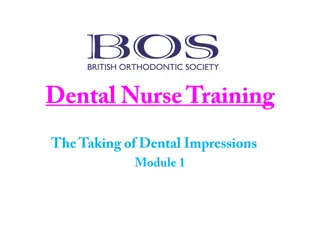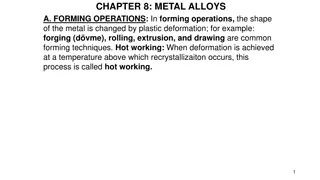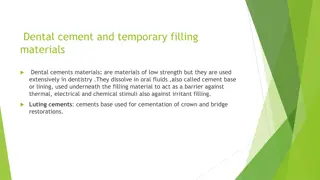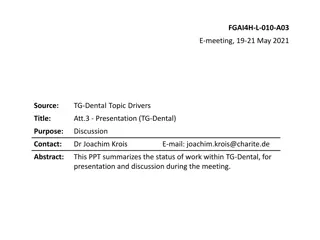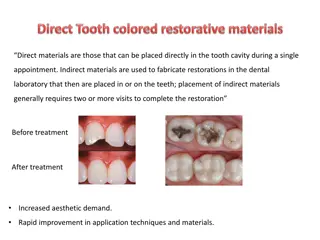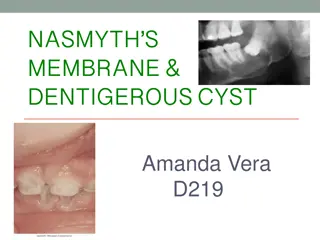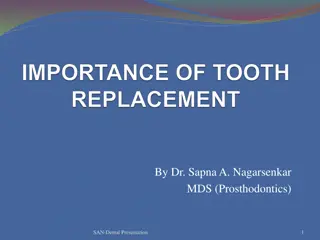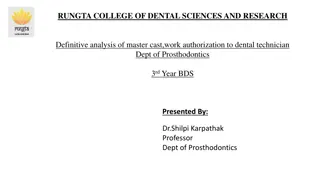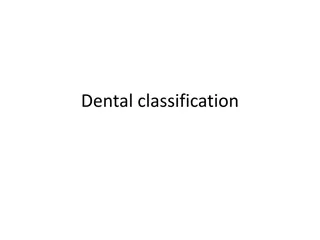Understanding Dental Alloys and Their Applications
Dental alloys play a crucial role in dentistry, offering properties like strength, biocompatibility, and ease of fabrication. They are categorized based on elements, nobility, and major components. Gold alloys, silver alloys, and other metal alloys find applications in various dental procedures such as crowns, bridges, and implants. The use of gold foil fillings highlights advantages and disadvantages associated with their properties. Understanding the classification and characteristics of dental alloys is essential for successful dental treatments.
Download Presentation

Please find below an Image/Link to download the presentation.
The content on the website is provided AS IS for your information and personal use only. It may not be sold, licensed, or shared on other websites without obtaining consent from the author. Download presentation by click this link. If you encounter any issues during the download, it is possible that the publisher has removed the file from their server.
E N D
Presentation Transcript
Metal and Metal alloy Alloy : is a metal containing two or more elements at least one of which is a metal and all of which are mutually soluble in the molten state.
Requirements of casting alloys: 1. They must not tarnish or corrode in the mouth; 2. They must be sufficiently strong for intended purpose. 3. They must be compatible ( nontoxic ,not allergic) 4. They must easy to melt, cast, cut, grind (easy to fabricate) 5. They must flow well and duplicate fine details during casting 6. They must have minimum shrinkage on cooling after casting 7. They must easy to solder.
Applications of metal alloys 1. Construction of metallic frame work of removable partial denture 2. Construction of metal core of crown and bridge 3. Making orthodontic wires ,bands ,brackets ,etc 4. Making endodontic instrument 5. Construction of metal implants Classification of metals Nobel metals: like gold, platinum, rhodium, ruthenium ,iridium ,osmium ,silver. However, in the oral cavity silver is not considered Nobel because of tarnish. Non Nobel metals (base metals): like Chromium, cobalt, nickel , iron , copper , etc
Classification of dental alloys A- According to number of elements: 1. Binary ---2. Ternary --- 3. Quaternary B-According to nobility 1. High Nobel alloys---contain 40% gold or more and 60% Nobel or more 2. Nobel alloys ---contain 25% or more Nobel metals 3. Base metal alloys ---contain less than 25% Nob.
C-According to major elements 1. Gold alloys 2. Silver alloys 3. Palladium alloys 4. Nickel alloys 5. Cobalt alloys 6. Titanium alloys
Gold Gold foil filling (pure gold) Pure gold is very malleable and ductile. Gold foil is in the form of very thin sheath or foil about 0.001 mm thickness. It is condensed into the cavity and each layer of foil become welded to the material already condensed. Advantages of gold foil filling Perfect corrosion resistance Adequate mechanical properties , Very durable Disadvantages Highly expensive Not esthetic The technique is time consuming and depends on the skill of operator
GOLD ALLOY They are classified according to yield strength and percentage of elongation Type 1 --- soft ---it is indicated for small inlay restoration not subjected to mastication stress like class 5 and class 3 Type 11 medium it is indicated for large inlay restoration Type 111 hard --- it is indicated for crown and bridge Type 1v extra hard it is indicated for crown and bridge and mainly for removable partial denture frames
Composition of gold alloys Gold, copper, silver, palladium, and some platinum, zinc, tin , and iron . Copper reduce melting point and density, increase hardness, gives red color to gold. If high % it reduce corrosion resistance and tarnish resistance. Silver ----whiten the alloy .increase strength and hardness slightly. In large amount it reduce tarnish resistance. Platinum -----increase strength corrosion resistance and melting point .has white color. Palladium ----- it hardens and whitens the alloy, raise the fusing temperature increase tarnish resistance .it is less expensive than gold. Zinc -----acts as scavenger
Properties 1. Color it is yellow and there is white gold depending on the whitening elements present (silver, platinum, palladium) 2. Melting range _-920-960 C 3. Density for pure gold is 19.3gm/cm3 .gold alloys have less density. 4. Yield strength ---for type 111 -207 MPa .for type 1v 275 Mpa 5. Hardness ---for type 111 121 MPa. For type 1v -----149 MPa 10. 6. Elongation ----type 111 30%-40%. For type 1v -----30%-40% 7. Resistant to tarnish and corrosion because of high Nobel metal content 8. Casting shrinkage is less than 1.25 1.65% 9. They are relatively biocompatible. 10. Gypsum bonded investment is used when the melting temp. is below 700 C.
Alternatives to gold alloys 1. Silver-palladium alloys They are cheaper than gold alloys .whiter in color and their properties are similar to type 111 and type 1v gold alloys but: lower density Lower ductility Lower corrosion resistance 2. Titanium and titanium alloys Metal ceramic alloys They are alloys that are compatible with porcelain and capable of bonding to it. A layer of porcelain is fused to the alloy to give it natural tooth like appearance. Porcelain is brittle so these alloys reinforce the porcelain (ceramics) .they should have coefficient of expansion and contraction (CTE) matching that of porcelain.
Requirements of metal ceramic alloys 1. The melting temperature of the alloy should be higher than the porcelain firing temp. 2. CTE should be compatible with that of porcelain 3. It should resist creep 4. It should be able to bond with porcelain 5. It should have high stiffness (high modulus of elasticity) 6. It should not stain or discolor porcelain. Types of metal ceramic alloys 1. High Nobel (gold alloys) like: gold-palladium , gold palladium -silver 2. Nobel (palladium) like :palladium-silver, palladium gold, palladium -copper 3. Base metal alloys like: nickel-chromium, pure titanium, Titanium-aluminum- vanadium
Titanium titanium alloys They have excellent biocompatibility, light weight, good strength and passivation effect. Applications in dentistry 1. Dental implant 2. Root canal instruments
Properties of Titanium and Titanium alloys 3. Color ------white gray color 4. Density---- 1-4 gm/cm3 5. Modulus of elasticity----110 GPa , half rigid as base metal alloys 6. Melting temp. is high---1668 C, special equipment should be used 7. Coefficient of thermal expansion CTE 8.3*10 -6 cm/cm C. it is low compared to porcelain 12.7 14.2 *10 -6 cm/cm C. special low fusing porcelain is used with it. 8. Biocompatibility--- it is nontoxic and excellent biocompatibility with soft and hard tissue 9. Tarnish and corrosion resistance---passivation by the formation of titanium oxide layer to protect the metal from further oxidation 10. phosphate and ethyl silicate bonded investment is used for the casting
Nickel chromium alloys They are used for metal ceramic crown and bridge Composition. Nickel---------------61-81% Chromium---------11-27% Molybdenum-----2 9% Minor elements like beryllium, aluminum, and silica
